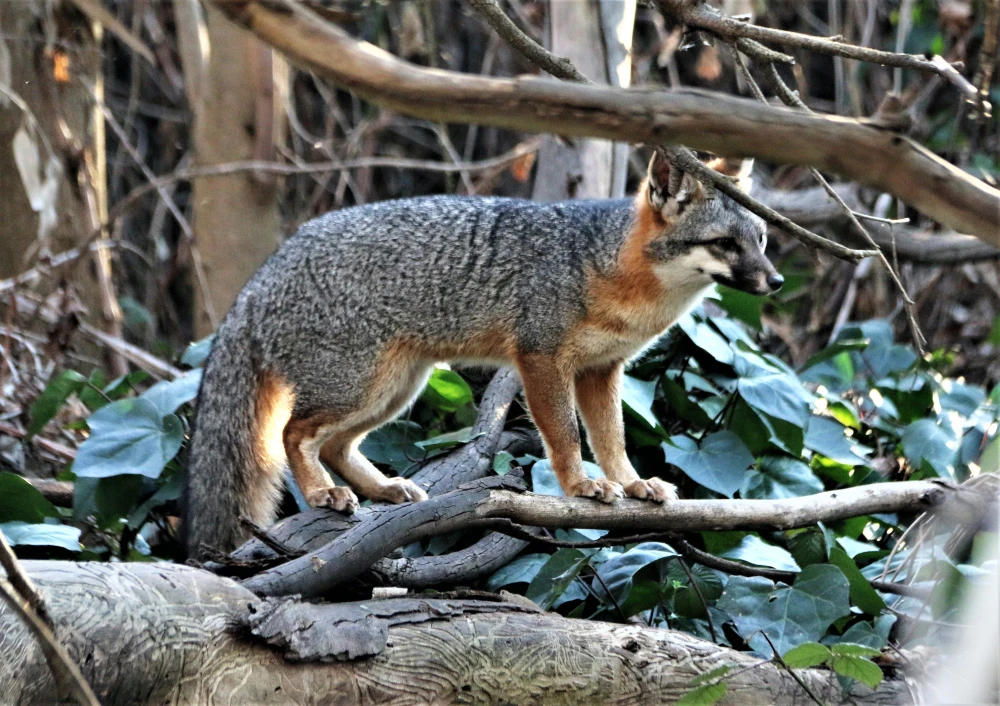Too Much Excitment & Gray Fox Naming
by William C. Leikam
President, CEO & Co-founder, Urban Wildlife Research Project
Please donate so that we can begin the collaring project. Your donation is tax deductible. The collaring project needs $25,000 and here’s the reason you need to donate to UWRP?
I need to make a slight correction on last month’s Gray Fox Report. I was so excited back when I wrote that entry, that I overstepped and blew past caution. I wrote, “The repopulation had begun… It was confirmed for from that time to the present here at the end of January 2019 the gray foxes both along Matadero Creek and at the perimeter of the water treatment plant, gray fox pairs have been showing and remaining in the region. The repopulation is taking place. Link to the video of the first daylight sighting of the first gray fox pair.
Let’s untangle this just a bit. Along Matadero Creek the pair that I reported on is still there along the creek and so they will remain having claimed that area as their home range. However, my contention that the pair that I picked up on my trail cameras along the road in Fox Hollow was premature. They had been hanging out for three days, but then they left the area. I asked myself, “Why would a pair like that not remain in the area?” The only reason I could come up with was that at some point there was a coyote in the region at the same time. I found its scat. Gray foxes are preyed upon by coyotes and so the foxes tend to put as much distance between them so as to live safely.
Over this past month, on my trail cameras and once-in-awhile live, I have seen this pair. (I don’t have names for them, yet. That will come as I see something unique in their behavior, distinct color marking, something that differentiates one from the other.) At this point too, I have no proof as to which one is male and which female. However, two days ago on video, the two of them foraged side-by-side along the ditch. I was able to see them still long enough to notice that down along the sides of one they bulged slightly, whereas the other one’s sides were slender. This distinction suggested that the one with the long neck and darker face was the male and the lighter colored one with the slightly flared sides was the pregnant female. She will have a litter of pups in early to mid-April.
From here on out, the story of these two gray foxes will emerge. Within the coming year, we will see how these two emerge as parents, see how well they can provide, see how they work with their pups to bring them from small black balls of fur with pudgy little noses and into their adult coloration. By then their noses have pushed out to become dog-like and into the equivalent of what we term their teenage years, just to the point to their dispersal. Together, you as the reader, I as the writer will take a journey into the lives of these gray foxes.
Gray Foxes General Health
The foxes are young, most likely first-year dispersals. They appear to be vibrant and healthy. Let’s keep them that way.
Total Numbers of Gray Foxes in the Palo Alto Baylands Nature Preserve
As of February 28, 2019, we have two resident gray foxes occupying the Palo Alto Baylands Nature Preserve.
- Check out our Facebook page.
- If you haven’t had a chance to read at least some of the articles that have been written about our study of gray fox behavior and our corridor work, click on these links as they will take you to the source: Bill Leikam – The Fox Guy, and Greg Kerekes & URWP
Section III
Gray Fox, Baylands Goals
Within the permit that allows the Urban Wildlife Research Project to conduct its study of the behavior of the gray fox at the Palo Alto Baylands Nature Preserve, the objectives covered area:
- Monitoring of urban gray fox Denning sites in Palo Alto Baylands.
This is being accomplished during the period when the gray foxes use a den site. It is one of the prime locations for gathering most of the behavioral data of the litter and for adults alike.
- Assessment of status and population trends of Baylands urban gray foxes
Since January 2019 a pair of resident gray foxes have claimed territory at the Palo Alto Baylands Nature Preserve.
- Identification of habitat features that promote the presence of urban gray foxes
After considering this and talking with people who know how to restore habitats, we need to assess what kinds of plants, including the Alkaline Salt Bush, would grow best along the edge of the saltwater channel and alongside the marsh. We need to grow a permanent habitat that contains the corridors and plant it as soon as possible. We’ll keep an eye on this as this is a critical link between the southern region of the Baylands and the northern region.
- Assessment of reproductive success and identification of factors that promote successful reproduction
Open up the pinch-point along Matadero Creek by developing thickets that link one area to another, instead of the present “islands”.
- Identification and assessment of possible dispersal travel routes.
Presently there can only be guesses as to dispersal travel routes. We intend to make this important question much more concrete when we attain our collaring/take/capture permit from the Department of Fish & Wildlife.




